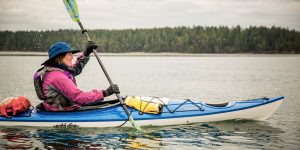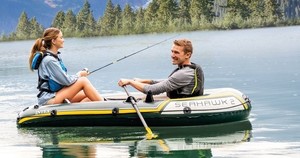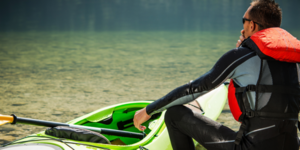What to Wear Kayaking
In this Guide
Whether you are an adventure enthusiast or an occasional tourist, if you love outdoors – being at the junction of waters and wilderness, then kayaking is one of the best activities you could partake in. And to make sure you enjoy the experience to the fullest, you need to be fully aware of what to wear while kayaking. Just like any other outdoor activity, it also requires certain clothing made of certain fabric to ensure your comfort and protection. From bodywear to headgear, this article will discuss what to wear while kayaking, in detail.
General Clothing Guidelines for Kayaking

Source: https://www.rei.com/learn/expert-advice/kayaking-what-to-wear.html
Before we go over the kayaking outfits in detail, we would like to put forward some basic clothing guidelines for your kayaking adventures.
Dress According to the Temperature of the Waters You’re Going in
This means that whenever you are going on a kayaking adventure, make sure that you dress up according to the temperature of the water instead of the general weather (air temperature). This will help you decide whether you want to go for a wetsuit or a drysuit.
Protection Against Sun is Important
Whenever you plan on going for kayaking, make sure you take the necessary steps to minimize those UV radiations from the Sun. And to do so, we advise you to use UPF rated clothing which is tested for this purpose. Also, the application of sunscreen on your face, arms, and legs is equally important. Even if the day seems cloudy, it is a wise choice to keep yourself well protected.
Avoid Cotton-Based Layers
Whenever you choose your kayaking gear, make sure it does not contain any cotton in it. It may feel soft and light, but it soaks up the water and makes the drying process prolonged. Choose the gear made of synthetic material mainly nylon-based or polyester-based. These are quick-dry materials that ensure your body does not get wet.
Choose Abrasion-Resistant Clothes
Always choose such clothes that are sturdy in nature and can hold up against rough usage. They should remain firm in their structure and should not wear out by the water, sand, or other such materials.
Always Wear a Personal Flotation Device (PFD)

A personal flotation device is the first thing you need to check off your list before sitting in your kayak. This ensures that in case of any mishap, you can stay afloat and face those rough waters. At times it can feel a bit tight and you may have to take adjust some layers (especially in cold weather) but always do that before you embark on your kayaking adventure. In case you need to do that while you are in the middle of the water, ask your buddy to hold your kayak firmly and keep it in the right direction. We would always advise you to adjust it beforehand and then launch your journey.
Avoid Clothes Which Contain Rustable Accessories
Always make sure that the gear you opt for does not contain any zippers, holders, or fasteners which are easily rustable. This will render your suit useless before you know it since changing these accessories is not convenient. Your kayak accessories are generally non-corrosive but that of your clothing is often not. So keeping this feature in mind will save you both money and peace in the longer run.
Keep Your Comfort First
Your comfort is what makes or breaks your kayaking experience. Therefore, always make sure that whatever you choose is comfortable and easy on your body.
Invest in synthetic layers
Avoid wearing regular jackets or coats (in cold weather) and invest in specialized synthetic layers that keep you warm and dry throughout your fun adventure.
How to Dress for Kayaking in Various Conditions
Now we will go over the specific kayaking clothing needed for different kinds of weather conditions, so you make a well-rounded and informed decision for your next trip.
What to Wear When Kayaking in the Summer

Tops
When kayaking in mild conditions, choose the options made of polyester or nylon. These offer a range of versatility – they are quick-drying, flexible, and provide UPF resistance for UV radiations. These synthetic options also ensure a better fit and an added grip.
Rashguards are an excellent go-to option for you to consider as they are blended with Lycra spandex. Other articles in this category are also reliable and offer great comfort.
Bottoms
For your lower half of the body, you can opt for a pair of shorts or trousers depending on what you prefer. Where the shorts keep your legs airy and cool, the trousers offer you a smooth layering for more protection. Make sure you go with synthetic options – made of polyester or nylon. The quick-dry feature is the most important when choosing your bottoms so you can stay dry and feel comfortable during your adventures. Yoga pants should not be used while kayaking since they are not made for rough usage and can make you uncomfortable in your cockpit.
Mid Layer
In mild and temperate conditions, a simple synthetic jacket can serve the purpose and keep you from the occasional winds. However, a water-proof fleece can also help if you do not want a synthetic option.
Outer Layer
Specialized water-proof paddling jackets are the best to wear while kayaking in moderate weather. These jackets are breathable which makes sure you do not feel hot inside and keep you from any splashes or rough waters during your adventure. They also have gaskets around the orifices to ensure no water goes inside. If it is just a casual short trip with friends, then your regular synthetic will work as well.
Footwear
We realize how wet feet can cause so much trouble and discomfort while kayaking. Therefore, always opt for water-resistant shoes/booties and consider them a one-time investment. These shoes have optimal strength and comfort and are completely water-resistant. To make them even more efficient, water-proof socks can be used which ensure your feet remain dry and fungus free. You can also use water-proof sandals but they can easily get muddy and full of sand, and your feet remain wet. We highly advise you to not wear flip-flops or such shoes that can not offer grip and support.
Underwear
In mild weather, a swimsuit can be used as your first layer and you are good to go. If you want added dryness then we would suggest a quick-dry nylon breathable underwear. Similarly, a sports bra is an excellent option underneath for your kayaking adventures. Just make sure it is not cotton-based.
Headgear
You can opt for a hat or a cap. We would suggest you choose one with a wider brim to give you the needed shade and keep you from the bright sun. Consider a chin strap to make sure your headgear does not fly away in strong winds.
Glasses retainers
To ensure your glasses do not fall off and then sink down to the bottom, we advise you to use retainers. They will ensure that your glasses remain on your face, and even if they fall off in the water, they remain on the surface afloat so you can quickly grab them.
Gloves
Some people prefer to wear gloves while kayaking for a better grip and added comfort. Paddling gloves are the most popular choice in the market and offering maximum protection against blisters as well. Similarly, pogies are another variant of kayaking gloves that are attached to the paddles ensuring a closed grip.
Personal Flotation Device
This is the most important thing to wear while kayaking – even if you’re just kayaking in shallow waters. It aids you in remaining afloat if you toss over and lessens the burden of swimming to save your life. It not only offers support but also offers comfort and warm experience to your torso. Make sure that you choose the one which fits you the best, and do not enter a kayak unless you have it on.
What to Wear When Kayaking in the Cold Weather

Source: https://probablyinteractive.com/skills-for-kayaking/
When kayaking in the cold weather, you pretty much have to dress up in order to remain dry and warm. Because the cold winds and the even colder water will cause shocks to your lungs and heart, and can easily lead to hypothermia. Dry-suit is the key here.
The usage of dry-suits or wet-suits majorly depends on the temperature. If the waters you are paddling in is 60 degrees Fahrenheit or lower, then a dry-suit is recommended. However, if the temperature is above 60 degrees then a wetsuit can be donned.
Upper Layers
In cold weather conditions, it is pivotal to have layers that effectively block winds and are water-proof. Your average quick-dry nylon may not work well, so make sure you add a synthetic thermal underneath. The gaskets are very important for your outer layers to keep you completely dry.
Bottoms
Full-length water-proof trousers or rain-pants are an excellent choice for your fall expeditions.
Footwear
Paddling boots with added straps offer you complete dryness and comfort. Water-proof thermal socks can be a useful addition.
Headgear
For those chilly days, we suggest you wear a close grip and comfortable beanie. These effectively block winds and even keep your ears warm.
Drysuits
If you are an avid kayaker who likes to go all out for adventure in the cold weather, you should opt for drysuits. These are particularly made for such conditions where warmth and dryness are needed the most. With added particles for water-resistance and wind blockage, its material is customized to give you proper comfort while kayaking. For additional warmth, it is suggested to wear long-sleeved thermals and nylon undergarments.
Layering with Drysuits and Wetsuits

Source: https://kayakingcircle.com/wetsuit-or-drysuit-when-kayaking-in-cold-waters/
Layering can be a hassle when you use a drysuit or a wetsuit. Let’s discuss each of the two cases.
Layering with a dry suit
For the inner layer, use synthetic and long-sleeved liners. Quick-dry undergarments with fleece lining may also serve the purpose.
For the mid-layer, you can add a thermal for your torso region.
For the outer layer, the drysuit itself is enough to keep you warm and dry. You can add on a wind-blocker jacket (north-face) if you feel cold.
Layering with a wetsuit
For the inner layer, a swimwear is enough as it offers easy changeability and better convenience.
For the mid-layer, the wetsuit itself serves the purpose, as it insulates you well. If you want increased insulation, then go for a thicker wetsuit.
There is no need for an outer layer with a wetsuit since it serves as a proper outer gear itself.
Final Thoughts
Whenever you plan to kayak, always make sure that you keep the proper clothing for yourself and your family (if they tag along as well). Quick-dry articles made from synthetic materials such as polyester or nylon are the options you should always consider when buying. Always avoid cotton and think of this gear as a long time investment. The abrasion-resistant clothes go a long way without compromising on your comfort.
Keep following us for more of such content. Hope our review helped you!
